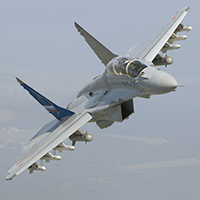Russia Introduces UB Version of MiG-35

First flown late last year, Russia’s MiG-35UB twin-seat light multirole fighter made its public debut on January 27 at manufacturer RAC MiG’s PK-1 (production complex No. 1) factory in Lukhovitsy, near Moscow.
A day earlier, chief test pilot Mikhail Belyaev, who is RAC MiG’s head of flight testing, had reported directly to President Vladimir Putin on the successful completion of initial flight tests of the UB combat trainer version of MiG-35, which was announced in 2005. Previously flown demonstrators and operational prototypes had “D” and “S” designations.
For the public introduction, RAC MiG invited reporters and military attaches from 30 countries to PK-1, where they were shown the twin-seat MiG-35UB, called Side 712, and a single-seat MiG-35 (Side 702). The MiG-35UBperformed a 10-minute demonstration flight with Belyaev and test pilot Stanislav Gorbunov at the controls. The manufacturer described the recently completed aircraft as representing a “renewed MiG-35” program, serving as specimens for future production.
“Today, we present to you the renewed MiG-35, a technologically new product featuring advanced construction materials, longer lifetime and advanced avionics,” said RAC MiG general director Ilya Tarasenko.
Outwardly, the Side 702 and 712 versions do not differ much from Sides 741 and 747, flown in 2012-2013, and representing MiG-35D twin-seat and MiG-35S single-seat prototypes, respectively. The difference is based on the use of a more advanced “integrated electro-optical system,” which United Aircraft Corporation (UAC) general designer Sergei Korotkov described as “multispectral” because it uses sensors operating in multiple wavebands of the light spectrum. In his turn, UAC president Yuri Slyusar said the “renewed MiG-35” will also have a modern laser system, without being specific.
RAC MiG acknowledges that the MiG-35 makes use of “highly successful MiG-29 aerodynamics,” and that “the true innovations are inside rather than out.” The manufacturer offers the MiG-35 with a service life of 6,000 flight hours or 40 years, both figures representing records for MiG aircraft.
The MiG-35 relies on Klimov RD–33MK engines from the MiG-29K/KUB. An engine replacement can be completed in field conditions within 58 minutes, “which is one of the best figures in the world,” the manufacturer says.